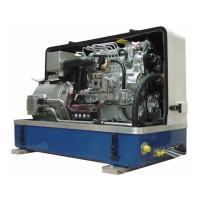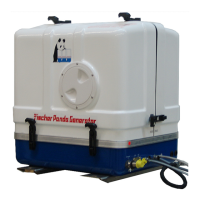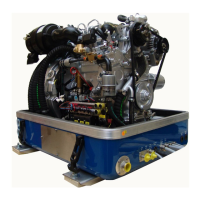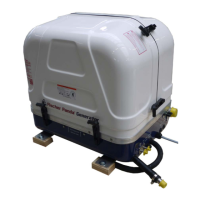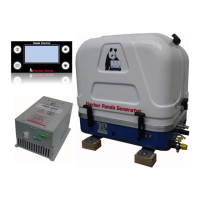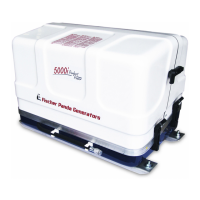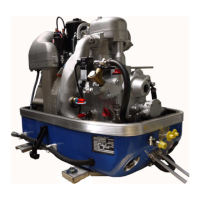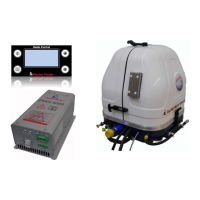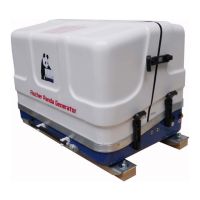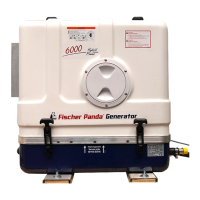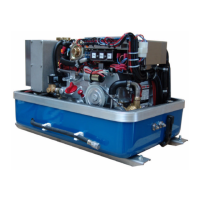Do you have a question about the Fischer Panda 12000x PMS and is the answer not in the manual?
General safety warnings and symbols for personal injury and equipment damage.
Identifies tools required for maintenance and installation tasks.
Declaration of conformity with Machinery Directive 2006/42/EC for generator assemblies.
Benefits of product registration and warranty information.
Key information and procedures for initial operation and warranty activation.
Comprehensive safety guidelines and precautions for operating the generator.
Guidance on careful handling and understanding the manual before equipment startup.
Emphasizes reading and understanding the manual and safety instructions.
Specifies required personal protective equipment for maintenance and repair work.
Importance of keeping the generator and its environment clean for safety.
Precautions for safely handling flammable fuels and lubricants.
Hazards of exhaust fumes and fire prevention measures.
Warnings and precautions related to hot components, pressurized systems, and battery hazards.
Instructions to avoid injury from moving parts like belts and fans.
Guidelines for safe handling and disposal of anti-freeze and other fluids.
Procedures for safety inspections and maintenance, including disconnection precautions.
Guidelines for maintaining and using warning and instruction signs.
Specific instructions and hazards related to generator operation and electrical safety.
Importance of protective conductors and potential equalisation for electrical safety.
Specifics on protective earthing for Panda AC generators.
Procedure to disconnect all loads before working on the generator.
Information on potential equalisation for specific DC generators.
Guidelines for selecting and installing appropriate cables.
Safety precautions for handling and connecting batteries.
Step-by-step guide for rescue breathing and CPR procedures.
Defines the primary purpose and proper application of the Fischer Panda generator.
Explains the manual's role and defines key personnel roles (trained, operator, user).
Defines qualifications for trained personnel for mechanical and electrical tasks.
Outlines the responsibilities and required knowledge for the operator/owner.
Defines the role and responsibilities of the user operating the generator.
Identifies and illustrates the main components of the Panda xGenerator system.
Briefly states the reliable power supply capability on vehicles.
Instructions for opening different types of Panda transport boxes.
Step-by-step guide to open the MPL sound insulation capsule using a screwdriver.
Instructions for opening the GFK sound insulation capsule with lash closures.
Guidelines for safely transporting and loading/unloading the generator.
Specifies upright transport and proper securing within the transport box.
Requirements for using appropriate eye bolts for loading and unloading.
Procedures for special servicing during extended downtimes and decommissioning.
Guidelines for maintaining the starter battery during extended periods of inactivity.
Recommended maintenance for short downtimes (1-3 months).
Procedures for medium-term downtimes or hibernation (3-6 months).
Steps for preserving the generator during medium-term storage.
Steps to remove protective measures before recommissioning after medium-term storage.
Procedures for extended downtimes or decommissioning (over 6 months).
Steps for preserving the generator during extended storage.
Steps to remove protective measures before recommissioning after extended storage.
Explains the information presented on the generator's type plate.
Provides detailed views and identification of the generator's components.
Identifies components visible from the right side of the generator.
Identifies components visible from the left side of the generator.
Identifies components visible from the front of the generator.
Identifies components visible from the back of the generator.
Identifies components visible from the top of the generator.
Explains key functional units and their purpose within the generator system.
Details the features and functions of the xControl panel for generator monitoring.
Illustrates the operational schematic of the generator's cooling system.
Illustrates the operational schematic of the generator's fuel system.
Describes the sensors and systems that monitor generator operation.
Illustrates the operational schematic of the generator's oil circuit.
Specifies qualifications and conditions for personnel operating the generator.
Highlights critical safety warnings and potential hazards during generator operation.
Provides general guidelines and procedures for operating the generator.
Instructions for operating the generator in low-temperature conditions.
Procedure for pre-heating the diesel motor before starting in cold conditions.
Recommendations for starter battery usage, especially in extreme weather.
Guidance on avoiding light load operation and its consequences like soot.
Explains the causes of generator soot formation.
Steps to prevent soot formation by proper load management.
Instructions on managing generator load and avoiding overloads for longevity.
Details on the generator's protective conductor system and grounding.
Overview of the generator's operating control system with sensors and switches.
Safety instructions regarding capacitors and their handling.
Procedures for pre-start checks, starting, and stopping the generator.
Specifies the qualifications for personnel performing generator installation.
Critical safety warnings and hazards associated with generator installation.
Guidelines for selecting an appropriate location for generator installation.
General considerations for generator placement, including air supply and sea cock operation.
Instructions for preparing the base and positioning the generator, considering accessibility.
Recommendations for achieving optimal sound insulation for the generator installation.
Instructions for making all electrical, fuel, and water connections to the generator.
Detailed instructions for installing the raw water cooling system.
General advice on the raw water cooling system installation.
Guidance on installing through-hull fittings for raw water intake on yachts.
Requirements for the raw water intake line's quality and diameter.
Considerations for installing the generator above the waterline, including pump access.
Specific instructions for installing the generator below the waterline, including vent valves.
Schematic diagram illustrating the raw water installation.
Instructions for installing the fresh water cooling system.
Guidelines for positioning the external cooling water expansion tank.
Procedure for ventilating the freshwater cooling system to remove air.
Instructions for installing the water-cooled exhaust system.
Steps for installing the standard exhaust system, including water lock placement.
Detailed instructions on the proper installation and function of the waterlock.
Identifies potential causes for water entering the exhaust hose.
Specific checks related to the exhaust hose for water ingress.
Specific checks related to the cooling water hose for water ingress.
Discusses the importance of the waterlock's installation area and potential issues.
Explains how to determine the correct volume for the waterlock.
Describes the ideal placement of the waterlock for optimal performance.
Illustrates off-center waterlock installations and their potential consequences.
Information on the exhaust/water separator and its role in noise reduction.
Guidelines for installing the exhaust water separator correctly.
Instructions for installing the fuel system components.
Lists the necessary items for fuel system installation.
Procedures for connecting fuel feed and return lines to the tank.
Specifies the correct placement for the pre-filter with a water separator.
Refers to the maintenance chapter for fuel system ventilation.
Instructions for installing the generator's DC electrical system.
Steps for connecting the starter battery block for the generator.
Instructions for installing the generator's AC electrical system.
Explains the electronic voltage control system using xControl.
Procedures for connecting the generator to the onboard AC power supply.
Details on the PEN protective conductor system and its connection.
Requirements for AC input electrical fuses and motor protection switches.
Recommendations for electrical cable dimensions based on safe installation standards.
Instructions for installing a disconnector/power source selector switch.
General special recommendations for installation.
Measures to prevent galvanic corrosion during installation.
Specific steps and measures to avoid galvanic corrosion.
Procedure for performing an isolation test before bringing the generator into service.
Steps for initial generator operation and record-keeping.
Specifies qualifications for personnel performing maintenance tasks.
Critical safety warnings and hazards related to maintenance and potential failures.
Guidelines for protecting the environment during maintenance and disposal.
Information on maintenance intervals, including potential extensions.
General procedures and checks for routine maintenance.
Daily pre-start checks for oil level, leaks, and general condition.
Inspection of hoses and rubber parts for wear and elasticity.
Specifies intervals and procedures for engine oil changes.
Detailed steps for checking the engine oil level.
Instructions for refilling engine oil when the level is low.
Final steps after checking and refilling the oil.
Step-by-step guide for replacing engine oil and the oil filter.
Procedures for checking the condition of the starter battery.
General checks for the battery and its connections.
Steps to ensure battery cleanliness and proper cable connections.
Procedure for checking the electrolyte level in the battery.
Method for measuring electrolyte density to determine battery charge status.
How to check and drain the water separator in the fuel supply.
Steps for replacing the air filter mat in the suction housing.
Procedure for replacing the air filter mat using a pull-out holder mechanism.
Steps for replacing the air filter using snap fasteners on the housing.
Procedure for ventilating the freshwater cooling system to remove air.
Guide for replacing the V-belt for the internal cooling water pump.
Information regarding the raw water circuit.
Instructions for cleaning the raw water filter.
Explains common causes for frequent impeller wear in the cooling water pump.
Step-by-step guide for replacing the impeller in the raw water pump.
Specifies qualifications for personnel involved in troubleshooting.
Critical safety warnings and hazards associated with troubleshooting generator faults.
Lists essential tools and instruments for managing generator disturbances.
A table listing common generator faults, their causes, and solutions.
Troubleshooting steps for low generator output voltage.
Troubleshooting steps for excessively high generator voltage.
Troubleshooting steps for fluctuating generator voltage.
Troubleshooting steps when the generator cannot start an electric motor.
Troubleshooting steps for when the diesel motor fails to start.
Troubleshooting steps when the starter motor turns but the engine doesn't start.
Troubleshooting steps for insufficient motor speed during starting.
Troubleshooting steps for an unsteady motor running condition.
Troubleshooting steps for instances where motor speed drops.
Troubleshooting steps for when the motor runs in an unexpected 'off' position.
Troubleshooting steps for when the motor stops unexpectedly.
Troubleshooting steps for a sooty or black exhaust indication.
Critical conditions requiring immediate shutdown of the generator.
Guidance on preventing and managing generator overloading.
Procedures for monitoring generator voltage and its importance for connected devices.
Explanation of automatic voltage monitoring and shutdown systems for protection.
Troubleshooting steps for low generator output voltage.
Troubleshooting for situations where the generator produces no voltage.
Explains rotor magnetism loss and the re-magnetising process.
Common engine starting issues and their troubleshooting.
Details on the optional lifting solenoid for motor stop functionality.
Provides detailed technical specifications for various Panda generator models.
Table showing the rated current for different generator models.
Guide for selecting appropriate cable cross-sections based on length and current.
Recommendations for suitable diesel fuel types and quality.
Information on engine oil classification, operating ranges, and quality standards.
Details on SAE classes and API designations for engine oils.
Explains SAE classes based on viscosity and temperature.
Explains API standards for engine oil quality.
Specifies recommended coolant types and properties, including Fischer Panda's product.
Table showing recommended coolant mixture ratios for different temperatures.
Table listing the required diameters for cooling water, exhaust, and fuel conduits.
Specifies requirements for personnel operating or installing the xControl system.
Critical safety warnings and precautions for using the Panda xControl system.
Identifies the main components of the xControl system (CP-G, GC-S, CB-G).
Description of the xControl CP-G as the display and control unit.
Description of the xControl GC-S as the main control module.
Description of the xControl CB-G as the external interface box.
Instructions for installing the xControl GC-S ECU.
Instructions for installing the xControl CB-G connection box.
Instructions for installing the xControl CP-G display and control unit.
Procedure for switching the generator on and entering standby mode.
Explains how the overview screen indicates when autostart is enabled.
Overview of the different screens displayed on the xControl panel.
Details the symbolic representations on the overview screens.
Displays overview screens with English text labels.
Displays overview screens with German text labels.
Step-by-step guide for starting the generator.
Daily checks and preparation steps for marine generator startup.
Daily checks and preparation steps for vehicle generator startup.
Detailed sequence for starting the generator using the xControl panel.
Procedures for safely stopping the generator.
Accessing the main menu to navigate through system settings.
Accessing the panel settings for brightness, language, etc.
Accessing generator-specific settings like autostart and fuel pump control.
How to adjust the brightness of the CP-G display.
How to adjust the contrast of the CP-G display.
How to set the standby timeout duration for the CP-G.
How to adjust the standby brightness of the CP-G display.
How to choose between symbolic or text view for overview screens.
How to select the display language (English/German) for text screens.
How to set the temperature unit (°C or °F) for display.
How to reset panel submenu settings to their default values.
How to navigate back to the main menu from a submenu.
Accessing generator-specific settings.
How to enable or disable the autostart feature for the generator.
How to configure the optional DC output settings.
How to set the operation mode for the optional DC-Power output.
How to configure the follow-up time for the optional DP output.
How to switch individual outputs (e.g., fuel pump, DC out) on or off.
How to view the event log for generator operational history and failures.
How to reset generator submenu settings to their factory defaults.
How to navigate back to the main menu from the generator submenu.
Step-by-step guide to change the display language from German to English.
Information on system failures, error messages, and symbols.
Explains various symbols and messages displayed on the xControl panel.
Example of a "Sensor defect" message and its display.
Example messages indicating a broken sensor or cable.
How failure codes are displayed when parameters are out of range.
A table detailing failure codes, causes, explanations, and warnings.
A reference guide to the various symbols used on the xControl display.
Dimensional drawings for the xControl CP-G unit.
General safety warnings and symbols for personal injury and equipment damage.
Identifies tools required for maintenance and installation tasks.
Declaration of conformity with Machinery Directive 2006/42/EC for generator assemblies.
Benefits of product registration and warranty information.
Key information and procedures for initial operation and warranty activation.
Comprehensive safety guidelines and precautions for operating the generator.
Guidance on careful handling and understanding the manual before equipment startup.
Emphasizes reading and understanding the manual and safety instructions.
Specifies required personal protective equipment for maintenance and repair work.
Importance of keeping the generator and its environment clean for safety.
Precautions for safely handling flammable fuels and lubricants.
Hazards of exhaust fumes and fire prevention measures.
Warnings and precautions related to hot components, pressurized systems, and battery hazards.
Instructions to avoid injury from moving parts like belts and fans.
Guidelines for safe handling and disposal of anti-freeze and other fluids.
Procedures for safety inspections and maintenance, including disconnection precautions.
Guidelines for maintaining and using warning and instruction signs.
Specific instructions and hazards related to generator operation and electrical safety.
Importance of protective conductors and potential equalisation for electrical safety.
Specifics on protective earthing for Panda AC generators.
Procedure to disconnect all loads before working on the generator.
Information on potential equalisation for specific DC generators.
Guidelines for selecting and installing appropriate cables.
Safety precautions for handling and connecting batteries.
Step-by-step guide for rescue breathing and CPR procedures.
Defines the primary purpose and proper application of the Fischer Panda generator.
Explains the manual's role and defines key personnel roles (trained, operator, user).
Defines qualifications for trained personnel for mechanical and electrical tasks.
Outlines the responsibilities and required knowledge for the operator/owner.
Defines the role and responsibilities of the user operating the generator.
Identifies and illustrates the main components of the Panda xGenerator system.
Briefly states the reliable power supply capability on vehicles.
Instructions for opening different types of Panda transport boxes.
Step-by-step guide to open the MPL sound insulation capsule using a screwdriver.
Instructions for opening the GFK sound insulation capsule with lash closures.
Guidelines for safely transporting and loading/unloading the generator.
Specifies upright transport and proper securing within the transport box.
Requirements for using appropriate eye bolts for loading and unloading.
Procedures for special servicing during extended downtimes and decommissioning.
Guidelines for maintaining the starter battery during extended periods of inactivity.
Recommended maintenance for short downtimes (1-3 months).
Procedures for medium-term downtimes or hibernation (3-6 months).
Steps for preserving the generator during medium-term storage.
Steps to remove protective measures before recommissioning after medium-term storage.
Procedures for extended downtimes or decommissioning (over 6 months).
Steps for preserving the generator during extended storage.
Steps to remove protective measures before recommissioning after extended storage.
Explains the information presented on the generator's type plate.
Provides detailed views and identification of the generator's components.
Identifies components visible from the right side of the generator.
Identifies components visible from the left side of the generator.
Identifies components visible from the front of the generator.
Identifies components visible from the back of the generator.
Identifies components visible from the top of the generator.
Explains key functional units and their purpose within the generator system.
Details the features and functions of the xControl panel for generator monitoring.
Illustrates the operational schematic of the generator's cooling system.
Illustrates the operational schematic of the generator's fuel system.
Describes the sensors and systems that monitor generator operation.
Illustrates the operational schematic of the generator's oil circuit.
Specifies qualifications and conditions for personnel operating the generator.
Highlights critical safety warnings and potential hazards during generator operation.
Provides general guidelines and procedures for operating the generator.
Instructions for operating the generator in low-temperature conditions.
Procedure for pre-heating the diesel motor before starting in cold conditions.
Recommendations for starter battery usage, especially in extreme weather.
Guidance on avoiding light load operation and its consequences like soot.
Explains the causes of generator soot formation.
Steps to prevent soot formation by proper load management.
Instructions on managing generator load and avoiding overloads for longevity.
Details on the generator's protective conductor system and grounding.
Overview of the generator's operating control system with sensors and switches.
Safety instructions regarding capacitors and their handling.
Procedures for pre-start checks, starting, and stopping the generator.
Specifies the qualifications for personnel performing generator installation.
Critical safety warnings and hazards associated with generator installation.
Guidelines for selecting an appropriate location for generator installation.
General considerations for generator placement, including air supply and sea cock operation.
Instructions for preparing the base and positioning the generator, considering accessibility.
Recommendations for achieving optimal sound insulation for the generator installation.
Instructions for making all electrical, fuel, and water connections to the generator.
Detailed instructions for installing the raw water cooling system.
General advice on the raw water cooling system installation.
Guidance on installing through-hull fittings for raw water intake on yachts.
Requirements for the raw water intake line's quality and diameter.
Considerations for installing the generator above the waterline, including pump access.
Specific instructions for installing the generator below the waterline, including vent valves.
Schematic diagram illustrating the raw water installation.
Instructions for installing the fresh water cooling system.
Guidelines for positioning the external cooling water expansion tank.
Procedure for ventilating the freshwater cooling system to remove air.
Instructions for installing the water-cooled exhaust system.
Steps for installing the standard exhaust system, including water lock placement.
Detailed instructions on the proper installation and function of the waterlock.
Identifies potential causes for water entering the exhaust hose.
Specific checks related to the exhaust hose for water ingress.
Specific checks related to the cooling water hose for water ingress.
Discusses the importance of the waterlock's installation area and potential issues.
Explains how to determine the correct volume for the waterlock.
Describes the ideal placement of the waterlock for optimal performance.
Illustrates off-center waterlock installations and their potential consequences.
Information on the exhaust/water separator and its role in noise reduction.
Guidelines for installing the exhaust water separator correctly.
Instructions for installing the fuel system components.
Lists the necessary items for fuel system installation.
Procedures for connecting fuel feed and return lines to the tank.
Specifies the correct placement for the pre-filter with a water separator.
Refers to the maintenance chapter for fuel system ventilation.
Instructions for installing the generator's DC electrical system.
Steps for connecting the starter battery block for the generator.
Instructions for installing the generator's AC electrical system.
Explains the electronic voltage control system using xControl.
Procedures for connecting the generator to the onboard AC power supply.
Details on the PEN protective conductor system and its connection.
Requirements for AC input electrical fuses and motor protection switches.
Recommendations for electrical cable dimensions based on safe installation standards.
Instructions for installing a disconnector/power source selector switch.
General special recommendations for installation.
Measures to prevent galvanic corrosion during installation.
Specific steps and measures to avoid galvanic corrosion.
Procedure for performing an isolation test before bringing the generator into service.
Steps for initial generator operation and record-keeping.
Specifies qualifications for personnel performing maintenance tasks.
Critical safety warnings and hazards related to maintenance and potential failures.
Guidelines for protecting the environment during maintenance and disposal.
Information on maintenance intervals, including potential extensions.
General procedures and checks for routine maintenance.
Daily pre-start checks for oil level, leaks, and general condition.
Inspection of hoses and rubber parts for wear and elasticity.
Specifies intervals and procedures for engine oil changes.
Detailed steps for checking the engine oil level.
Instructions for refilling engine oil when the level is low.
Final steps after checking and refilling the oil.
Step-by-step guide for replacing engine oil and the oil filter.
Procedures for checking the condition of the starter battery.
General checks for the battery and its connections.
Steps to ensure battery cleanliness and proper cable connections.
Procedure for checking the electrolyte level in the battery.
Method for measuring electrolyte density to determine battery charge status.
How to check and drain the water separator in the fuel supply.
Steps for replacing the air filter mat in the suction housing.
Procedure for replacing the air filter mat using a pull-out holder mechanism.
Steps for replacing the air filter using snap fasteners on the housing.
Procedure for ventilating the freshwater cooling system to remove air.
Guide for replacing the V-belt for the internal cooling water pump.
Information regarding the raw water circuit.
Instructions for cleaning the raw water filter.
Explains common causes for frequent impeller wear in the cooling water pump.
Step-by-step guide for replacing the impeller in the raw water pump.
Specifies qualifications for personnel involved in troubleshooting.
Critical safety warnings and hazards associated with troubleshooting generator faults.
Lists essential tools and instruments for managing generator disturbances.
A table listing common generator faults, their causes, and solutions.
Troubleshooting steps for low generator output voltage.
Troubleshooting steps for excessively high generator voltage.
Troubleshooting steps for fluctuating generator voltage.
Troubleshooting steps when the generator cannot start an electric motor.
Troubleshooting steps for when the diesel motor fails to start.
Troubleshooting steps when the starter motor turns but the engine doesn't start.
Troubleshooting steps for insufficient motor speed during starting.
Troubleshooting steps for an unsteady motor running condition.
Troubleshooting steps for instances where motor speed drops.
Troubleshooting steps for when the motor runs in an unexpected 'off' position.
Troubleshooting steps for when the motor stops unexpectedly.
Troubleshooting steps for a sooty or black exhaust indication.
Critical conditions requiring immediate shutdown of the generator.
Guidance on preventing and managing generator overloading.
Procedures for monitoring generator voltage and its importance for connected devices.
Explanation of automatic voltage monitoring and shutdown systems for protection.
Troubleshooting steps for low generator output voltage.
Troubleshooting for situations where the generator produces no voltage.
Explains rotor magnetism loss and the re-magnetising process.
Common engine starting issues and their troubleshooting.
Details on the optional lifting solenoid for motor stop functionality.
Provides detailed technical specifications for various Panda generator models.
Table showing the rated current for different generator models.
Guide for selecting appropriate cable cross-sections based on length and current.
Recommendations for suitable diesel fuel types and quality.
Information on engine oil classification, operating ranges, and quality standards.
Details on SAE classes and API designations for engine oils.
Explains SAE classes based on viscosity and temperature.
Explains API standards for engine oil quality.
Specifies recommended coolant types and properties, including Fischer Panda's product.
Table showing recommended coolant mixture ratios for different temperatures.
Table listing the required diameters for cooling water, exhaust, and fuel conduits.
Specifies requirements for personnel operating or installing the xControl system.
Critical safety warnings and precautions for using the Panda xControl system.
Identifies the main components of the xControl system (CP-G, GC-S, CB-G).
Description of the xControl CP-G as the display and control unit.
Description of the xControl GC-S as the main control module.
Description of the xControl CB-G as the external interface box.
Instructions for installing the xControl GC-S ECU.
Instructions for installing the xControl CB-G connection box.
Instructions for installing the xControl CP-G display and control unit.
Procedure for switching the generator on and entering standby mode.
Explains how the overview screen indicates when autostart is enabled.
Overview of the different screens displayed on the xControl panel.
Details the symbolic representations on the overview screens.
Displays overview screens with English text labels.
Displays overview screens with German text labels.
Step-by-step guide for starting the generator.
Daily checks and preparation steps for marine generator startup.
Daily checks and preparation steps for vehicle generator startup.
Detailed sequence for starting the generator using the xControl panel.
Procedures for safely stopping the generator.
Accessing the main menu to navigate through system settings.
Accessing the panel settings for brightness, language, etc.
Accessing generator-specific settings like autostart and fuel pump control.
How to adjust the brightness of the CP-G display.
How to adjust the contrast of the CP-G display.
How to set the standby timeout duration for the CP-G.
How to adjust the standby brightness of the CP-G display.
How to choose between symbolic or text view for overview screens.
How to select the display language (English/German) for text screens.
How to set the temperature unit (°C or °F) for display.
How to reset panel submenu settings to their default values.
How to navigate back to the main menu from a submenu.
Accessing generator-specific settings.
How to enable or disable the autostart feature for the generator.
How to configure the optional DC output settings.
How to set the operation mode for the optional DC-Power output.
How to configure the follow-up time for the optional DP output.
How to switch individual outputs (e.g., fuel pump, DC out) on or off.
How to view the event log for generator operational history and failures.
How to reset generator submenu settings to their factory defaults.
How to navigate back to the main menu from the generator submenu.
Step-by-step guide to change the display language from German to English.
Information on system failures, error messages, and symbols.
Explains various symbols and messages displayed on the xControl panel.
Example of a "Sensor defect" message and its display.
Example messages indicating a broken sensor or cable.
How failure codes are displayed when parameters are out of range.
A table detailing failure codes, causes, explanations, and warnings.
A reference guide to the various symbols used on the xControl display.
Dimensional drawings for the xControl CP-G unit.
| Voltage | 230 V |
|---|---|
| Frequency | 50 Hz |
| Fuel Type | Diesel |
| Model/Type | Fischer Panda 12000x PMS |
| Phase | 1 |
